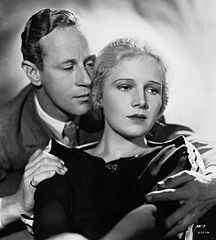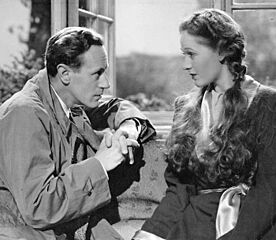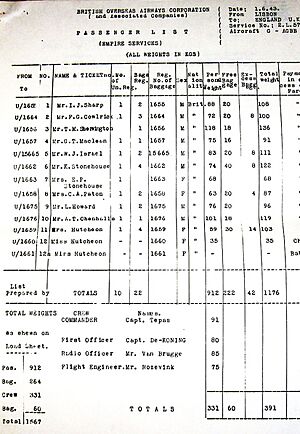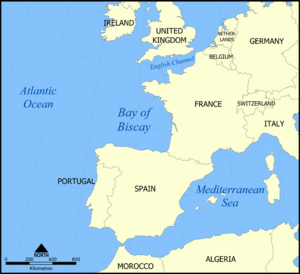Leslie Howard facts for kids
Quick facts for kids
Leslie Howard
|
|
|---|---|
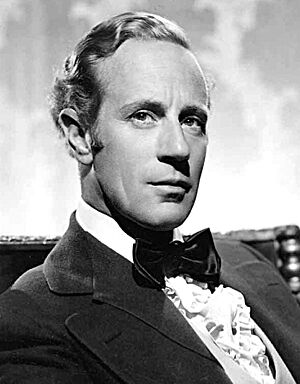
Howard as Ashley Wilkes in Gone with the Wind, 1939
|
|
| Born |
Leslie Howard Steiner
3 April 1893 Forest Hill, London, England
|
| Died | 1 June 1943 (aged 50) At sea off the coast of Galicia, Spain, near Cedeira
|
| Cause of death | Aircraft shot down |
| Occupation |
|
| Years active | 1913–1943 |
| Known for |
|
| Spouse(s) |
Ruth Evelyn Martin
(m. 1916) |
| Children | 2, including Ronald |
Leslie Howard Steiner (3 April 1893 – 1 June 1943) was an English actor, director, producer and writer. He wrote many stories and articles for The New York Times, The New Yorker, and Vanity Fair and was one of the biggest box-office draws and movie idols of the 1930s.
Active in both Britain and Hollywood, Howard played Ashley Wilkes in Gone with the Wind (1939). He had roles in many other films, often playing the quintessential Englishman, including Berkeley Square (1933), Of Human Bondage, The Scarlet Pimpernel (both 1934), The Petrified Forest (1936), Pygmalion (1938), Intermezzo (1939), "Pimpernel" Smith (1941), and The First of the Few (1942). He was nominated for the Academy Award for Best Actor for Berkeley Square and Pygmalion.
Howard's Second World War activities included acting and filmmaking. He helped to make anti-German propaganda and shore up support for the Allies—two years after his death the British Film Yearbook described Howard's work as "one of the most valuable facets of British propaganda". He was rumoured to have been involved with British or Allied Intelligence, sparking conspiracy theories regarding his death in 1943 when the Luftwaffe shot down BOAC Flight 777 over the Atlantic (off the coast of Cedeira, A Coruña), on which he was a passenger.
Contents
Early life
Howard was born Leslie Howard Steiner to a British mother, Lilian (née Blumberg), and a Hungarian Jewish father, Ferdinand Steiner, in Forest Hill, London. His younger brother was actor Arthur Howard. Lilian had been raised as a Christian, but she was of partial Jewish ancestry—her paternal grandfather Ludwig Blumberg, a Jewish merchant originally from East Prussia, had married into the English upper-middle classes.
He received his formal education at Alleyn's School, London. Like many others around the time of the First World War, the family anglicised its name, in this case to "Stainer", although Howard's name remained Steiner in official documents, such as his military records.
Howard was a 21-year-old bank clerk in Dulwich when the First World War began; in September 1914 he voluntarily enlisted (under the name Leslie Howard Steiner) as a Private with the British Army's Inns of Court Officer Training Corps in London. In February 1915 he received a commission as a subaltern with the 3/1st Northamptonshire Yeomanry, with which he trained in England until 19 May 1916, when he resigned his commission and was medically discharged from the British Army with neurasthenia.
In March 1920, Howard gave public notice in The London Gazette that he had changed his surname, and would thereafter be known by the name of Howard instead of Steiner.
Theatre career
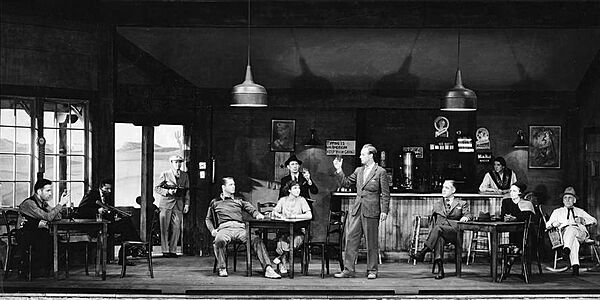
Howard began his professional acting career in regional tours of Peg O' My Heart and Charley's Aunt in 1916–17 and on the London stage in 1917, but had his greatest theatrical success in the United States in Broadway theatre, in plays such as Aren't We All? (1923), Outward Bound (1924) and The Green Hat (1925). He became an undisputed Broadway star in Her Cardboard Lover (1927). After his success as time traveller Peter Standish in Berkeley Square (1929), Howard launched his Hollywood career in the film version of Outward Bound, but didn't like the experience and vowed never to return to Hollywood. However, he did return, many times—later repeating the Standish role in the 1933 film version of Berkeley Square.
The stage, however, continued to be an important part of his career. Howard frequently juggled acting, producing and directing duties in the Broadway productions in which he starred. Howard was also a dramatist, and starred in the Broadway production of his own play Murray Hill (1927). He played Matt Denant in John Galsworthy's 1927 Broadway production Escape in which he first made his mark as a dramatic actor. His stage triumphs continued with The Animal Kingdom (1932) and The Petrified Forest (1934). He later repeated both roles in the film versions.
Howard loved to play Shakespeare, but according to producer John Houseman he could be lazy about learning lines. He first sprang to fame playing in Romeo and Juliet (1936) in the role of the leading man. During the same period he had the misfortune to open on Broadway in Hamlet (1936) just a few weeks after John Gielgud launched a rival production of the same play that was far more successful with both critics and audiences. Howard's production, his final stage role, lasted for only 39 performances before closing.
Howard was inducted into the American Theatre Hall of Fame in 1981.
Film career
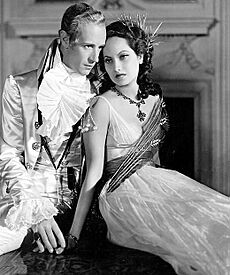
In 1920 Howard suggested to his friend Adrian Brunel that they form a film production company. After Howard's initial suggestion of calling it British Comedy Films Ltd., the two eventually settled on the name Minerva Films Ltd. The company's board of directors consisted of Howard, Brunel, C. Aubrey Smith, Nigel Playfair and A. A. Milne. One of the company's investors was H. G. Wells. Although the films produced by Minerva—which were written by A. A. Milne—were well received by critics, the company was only offered £200 apiece for films that cost it £1,000 to produce, and Minerva Films was short-lived. Early films include four written by A. A. Milne, including The Bump, starring C. Aubrey Smith; Twice Two; Five Pounds Reward; and Bookworms, the latter two starring Howard. Some of these films survive in the archives of the British Film Institute.
In British and Hollywood productions, Howard often played stiff upper lipped Englishmen. He appeared in the film version of Outward Bound (1930), though in a different role from the one he portrayed on Broadway. He had second billing under Norma Shearer in A Free Soul (1931), which also featured Lionel Barrymore and future Gone With the Wind rival Clark Gable eight years prior to their Civil War masterpiece. He starred in the film version of Berkeley Square (1933), for which he was nominated for an Academy Award for Best Actor. He played the title role in The Scarlet Pimpernel (1934), which is often considered the definitive portrayal.
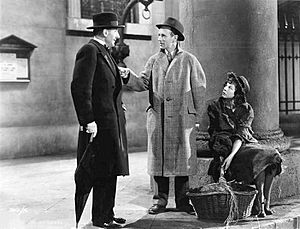
When Howard co-starred with Bette Davis in The Petrified Forest (1936) – having earlier co-starred with her in the film adaptation of W. Somerset Maugham's book Of Human Bondage (1934) – he reportedly insisted that Humphrey Bogart play gangster Duke Mantee, repeating his role from the stage production. This re-launched Bogart's screen career, and the two men became lifelong friends; Bogart and Lauren Bacall later named their daughter "Leslie Howard Bogart" after him. In the same year Howard starred with Norma Shearer in a film version of Shakespeare's Romeo and Juliet (1936).
Bette Davis was again Howard's co-star in the romantic comedy It's Love I'm After (1937) (also co-starring Olivia de Havilland). He played Professor Henry Higgins in the film version of George Bernard Shaw's play Pygmalion (1938), with Wendy Hiller as Eliza, which earned Howard another Academy Award nomination for Best Actor. In 1939, as war approached, he played opposite Ingrid Bergman in Intermezzo; that August, Howard was determined to return to the country of his birth. He was eager to help the war effort, but lost any support for a new film, instead being obliged to relinquish £20,000 of holdings in the US before he could leave the country.
Howard is perhaps best remembered for his role as Ashley Wilkes in Gone with the Wind (1939), his last American film, but he was uncomfortable with Hollywood, and returned to Britain to help with the Second World War effort. He starred in a number of Second World War films, including 49th Parallel (1941), "Pimpernel" Smith (1941) and The First of the Few (1942, known in the U.S. as Spitfire), the latter two of which he also directed and co-produced. His friend and The First of the Few co-star David Niven said Howard was "...not what he seemed. He had the kind of distraught air that would make people want to mother him. Actually, he was about as naïve as General Motors. Busy little brain, always going."
In 1944, after his death, British exhibitors voted him the second-most popular local star at the box office. His daughter said he was a "remarkable man".
-
Howard and Ann Harding in The Animal Kingdom (1932)
-
Howard and Myrna Loy in The Animal Kingdom (1932)
-
Howard and Norma Shearer in Romeo and Juliet (1936)
-
Romeo and Juliet (1936) lobby card with John Barrymore and Basil Rathbone
Personal life
Howard married Ruth Evelyn Martin (1895–1980) in March, 1916, and their children Ronald "Winkie" (1918–1996) and Leslie Ruth "Doodie" (1924–2013) who appeared with her father and David Niven in the film The First of the Few (1942), playing the role of nurse to David Niven's character, and as a major contributor in the filmed biography of her father, Leslie Howard: The Man Who cared. His son, Ronald Howard, became an actor and played the title role in the television series Sherlock Holmes (1954). His younger brother Arthur was also an actor, primarily in British comedies. His sister Irene was a costume designer and a casting director for Metro-Goldwyn-Mayer. His sister Doris Stainer founded the Hurst Lodge School in Sunningdale, Berkshire, in 1945 and remained its headmistress until the 1970s.
The Howard family's home in Britain was Stowe Maries, a 16th-century, six-bedroom farmhouse on the edge of Westcott, Surrey. His will revealed an estate of £62,761, the equivalent of £2 million as of 2021. An English Heritage blue plaque was placed at 45 Farquhar Road, Upper Norwood, London in 2013.
Death
In May 1943, Howard travelled to Portugal to promote the British cause. He stayed in Monte Estoril, at the Hotel Atlântico, between 1 May and 4 May, then again between 8 May and 10 May and again between 25 May and 31 May 1943. The following day, 1 June 1943, he was aboard KLM Royal Dutch Airlines/BOAC Flight 777, "G-AGBB" a Douglas DC-3 flying from Lisbon to Bristol, when it was shot down by Luftwaffe Junkers Ju 88 C-6 maritime fighter aircraft over the Atlantic (off Cedeira, A Coruña). He was among the 17 fatalities, including four KLM flight crew.
The BOAC DC-3 Ibis had been operating on a scheduled Lisbon–Whitchurch route throughout 1942–43 that did not pass over what would commonly be referred to as a war zone. By 1942, however, the Germans considered the region an "extremely sensitive war zone". On two occasions, 15 November 1942 and 19 April 1943, the camouflaged airliner had been attacked by Messerschmitt Bf 110 fighters (a single aircraft and six Bf 110s, respectively) whilst en route; each time, the pilots escaped by evasive tactics.
On 1 June 1943, "G-AGBB" again came under attack by a swarm of eight V/KG40 Ju 88 C-6 maritime fighters. The DC-3's last radio message indicated it was being fired upon at longitude 09.37 West, latitude 46.54 North.
According to German documents, the DC-3 was shot down at 46°07′N 10°15′W / 46.117°N 10.250°W, some 500 miles (800 km) from Bordeaux, France, and 200 miles (320 km) northwest of La Coruña, Spain. Luftwaffe records indicate that the Ju 88 maritime fighters were operating beyond their normal patrol area to intercept and shoot down the aircraft. Oberleutnant Herbert Hintze, Staffelkapitän of 14 Staffel, V./Kampfgeschwader 40, and based in Bordeaux, stated that his Staffel shot down the DC-3 because it was recognized as an enemy aircraft.
Hintze further stated that his pilots were angry that the Luftwaffe leaders had not informed them of a scheduled flight between Lisbon and the UK, and that had they known, they could easily have escorted the DC-3 to Bordeaux and captured it and all aboard. The German pilots photographed the wreckage floating in the Bay of Biscay, and after the war, copies of these captured photographs were sent to Howard's family.
The following day, a search of the waters on the route was undertaken by "N/461", a Short Sunderland flying boat from No. 461 Squadron RAAF. Near the same coordinates where the DC-3 was shot down, the Sunderland was attacked by eight Ju 88s and, after a furious battle, it managed to shoot down three of the attackers, with an additional three "possibles", before crash-landing at Praa Sands near Penzance. In the aftermath of these two actions, all BOAC flights from Lisbon were re-routed and operated only under the cover of darkness.
The news of Howard's death was published in the same issue of The Times that reported the "death" of Major William Martin, the "Man who never was" created for the ruse involved in Operation Mincemeat.
Theories regarding the air attack
A long-standing but ultimately unsupported hypothesis suggested that the Germans believed that the British Prime Minister, Winston Churchill, was on board the flight. Churchill's history of World War II suggested that the Germans targeted the commercial flight because the British Prime Minister's "presence in North Africa [for the 1943 Casablanca conference] had been fully reported", and German agents at the Lisbon airfield mistook a "thickset man smoking a cigar" boarding the plane for Churchill returning to England. This thickset man was Howard's agent, Alfred Chenhalls. The death of the fourteen civilians including Leslie Howard "was a painful shock to me", Churchill wrote; "the brutality of the Germans was only matched by the stupidity of their agents".
Two books focusing on the final flight, Flight 777 (Ian Colvin, 1957) and In Search of My Father: A Portrait of Leslie Howard (Ronald Howard, 1984), asserted that the target was Howard instead: that Germans deliberately shot down Howard's DC-3 to demoralise Britain. Howard had been travelling through Spain and Portugal lecturing on film, but also meeting with local propagandists and shoring up support for the Allies. The British Film Yearbook for 1945 described Leslie Howard's work as "one of the most valuable facets of British propaganda".
The Germans could have suspected even more surreptitious activities, since Portugal, like Switzerland, was a crossroads for internationals and spies from both sides. British historian James Oglethorpe investigated Howard's connection to the secret services. Ronald Howard's book explores the written German orders to the Ju 88 squadron in great detail, as well as British communiqués that purportedly verify intelligence reports indicating a deliberate attack on Howard. These accounts indicate that the Germans were aware of Churchill's real whereabouts at the time and were not so naïve as to believe he would be travelling alone on board an unescorted, unarmed civilian aircraft, which Churchill also acknowledged as improbable. Ronald Howard was convinced the order to shoot down Howard's airliner came directly from Joseph Goebbels, Minister of Public Enlightenment and Propaganda in Nazi Germany, who had been ridiculed in one of Leslie Howard's films, and believed Howard to be the most dangerous British propagandist.
Most of the 13 passengers were either British businessmen with commercial connections to Portugal, or lower-ranking British government civil servants. There were also two or three children of British military personnel. Two passengers were bumped off the flight, George and William Cecil, the teenage sons of Cornelia Stuyvesant Vanderbilt, who had been recalled to London from their Swiss boarding school, thus saving their lives.
A 2008 book by Spanish writer José Rey Ximena argues that Howard was on a top-secret mission for Churchill to dissuade Spanish dictator Francisco Franco from joining the Axis powers. Via an old girlfriend, Conchita Montenegro, Howard had contacts with Ricardo Giménez Arnau, a young diplomat in the Spanish Ministry of Foreign Affairs.
Further merely circumstantial background evidence is revealed in Jimmy Burns's 2009 biography of his father, spymaster Tom Burns. According to author William Stevenson in A Man Called Intrepid, his biography of Sir William Samuel Stephenson (no relation), the senior representative of British Intelligence for the western hemisphere during the Second World War, Stephenson postulated that the Germans knew about Howard's mission and ordered the aircraft shot down. Stephenson further argued that Churchill knew in advance of the German intention to shoot down the aircraft, but allowed it to proceed to protect the fact that the British had broken the German Enigma code. Former CIA agent Joseph B. Smith recalled that, in 1957, he was briefed by the National Security Agency on the need for secrecy and that Leslie Howard's death had been brought up. The NSA stated that Howard knew his aircraft was to be attacked by German fighters and risked himself to protect the British code-breakers.
A secretly taped account by one of the pilots involved appears in Sönke Neitzel and Harald Welzer's Soldiers: German POWs on Fighting, Killing, and Dying. In a recently declassified transcript of a surreptitiously recorded conversation by two German Luftwaffe prisoners of war talking about the shooting down of Howard's flight, one seems to express pride in his accomplishment, but states clearly he knew nothing of the passengers' identities or importance until hearing an English broadcast later that evening. Asked why he shot down a civil aircraft, he states it was one of four such planes he shot down: "Whatever crossed our path was shot down."
The 2010 biography by Estel Eforgan, Leslie Howard: The Lost Actor, examines then recently available evidence and concludes that Howard was not a specific target, corroborating the statements by German sources that the shootdown was "an error in judgement".
There is a monument in San Andrés de Teixido, Spain, dedicated to the victims of the crash. Howard's aircraft was shot down over the sea north of this village.
The Mystery of Flight 777 (documentary)
The Mystery of Flight 777, by film-maker Thomas Hamilton, explores the circumstances, theories and myths which have grown around the shooting down of Howard's plane. The film also aims to examine in detail some of the other passengers on board. Originally intended as a short companion piece to the Leslie Howard film, this project expanded in scope and as of January 2021 is still in production.
Biographies
Howard's premature death preempted any autobiography. A compilation of his writings, Trivial Fond Records, edited and with occasional comments by his son Ronald, was published in 1982. This book includes insights on his family life, first impressions of America and Americans when he first moved to the United States to act on Broadway, and his views on democracy in the years prior to and during the Second World War.
Howard's son and daughter each published memoirs of their father: In Search of My Father: A Portrait of Leslie Howard (1984) by Ronald Howard, and A Quite Remarkable Father: A Biography of Leslie Howard (1959) by Leslie Ruth Howard.
Estel Eforgan's Leslie Howard: The Lost Actor is a full-length book biography published in 2010.
Leslie Howard: The Man Who cared
Leslie Howard: A Quite Remarkable Life, as it was initially known, is a film documentary biography produced by Thomas Hamilton of Repo Films. It was shown privately at the NFB Mediatheque, Toronto, Canada in September 2009 for contributors and supporters of the film. Subsequently, re-edited and retitled Leslie Howard: The Man Who cared, the documentary was officially launched on 2 September 2011 in an event held at Howard's former home "Stowe Maries" in Dorking, and reported on BBC South News the same day. Lengthy rights negotiations with Warners then delayed further screenings until May 2012.
From 2012 to early 2014 the film remained in limbo due to these issues. However, in early 2014, independent producer Monty Montgomery and Hamilton entered a co-production agreement to complete and release the documentary. This involved a complete re-edit of the documentary, from June 2014 to February 2015, with added material including archival interviews (Michael Powell, John Houseman, Ronald Howard and Irene Howard - all originally filmed in 1980 for the BBC's British Greats series), much historical footage and an additional interview. In addition a score was commissioned from composer Maria Antal and considerable post-production sweetening was undertaken on the original material.
This new version, of Leslie Howard: The Man Who cared was screened as a "work in progress" at the San Francisco Mostly British Film Festival on 14 February 2015, with Hamilton, Tracy Jenkins and Derek Partridge in attendance. The film won the award for Best Documentary Film.
Subsequent screenings (with minor changes to the commentary) took place at the Chichester International Film Festival on 18 August 2015 at the Regent Street Cinema, London in December 2015 and at the Margaret Mitchell Museum in Atlanta in May 2016 as part of the Britweek Atlanta launch.
Leslie Howard: The Man Who cared had its world premiere broadcast on Talking Pictures TV on 27 December 2017, followed by the US TV premiere on Turner Classic Movies on 4 June 2018, which opened a month-long tribute to Howard's films. It airs regularly on Talking Pictures TV and occasionally on Turner Classic Movies.
Complete filmography
| Year | Country | Title | Credited as | |||||
|---|---|---|---|---|---|---|---|---|
| Director | Producer | Actor | Screenwriter | Role | Notes | |||
| 1914 | UK | The Heroine of Mons | Yes | Short | ||||
| 1917 | UK | The Happy Warrior | Yes | Rollo | ||||
| 1919 | UK | The Lackey and the Lady | Yes | Tony Dunciman | ||||
| 1920 | UK | Twice Two | Yes | Short | ||||
| 1920 | UK | The Bump | Yes | Short | ||||
| 1920 | UK | Bookworms | Yes | Yes | Richard | Short | ||
| 1920 | UK | Five Pounds Reward | Yes | Yes | Tony Marchmont | Short | ||
| 1921 | UK | Two Many Cooks | Yes | Short | ||||
| 1921 | UK | The Temporary Lady | Yes | Short | ||||
| 1930 | US | Outward Bound | Yes | Tom Prior | ||||
| 1931 | US | Never the Twain Shall Meet | Yes | Dan Pritchard | ||||
| 1931 | US | A Free Soul | Yes | Dwight Winthrop | ||||
| 1931 | US | Five and Ten | Yes | Bertram "Berry" Rhodes | ||||
| 1931 | US | Devotion | Yes | David Trent | ||||
| 1932 | UK | Service for Ladies | Yes | Max Tracey | ||||
| 1932 | US | Smilin' Through | Yes | Sir John Carteret | ||||
| 1932 | US | The Animal Kingdom | Yes | Tom Collier | ||||
| 1933 | US | Secrets | Yes | John Carlton | ||||
| 1933 | US | Captured! | Yes | Captain Fred Allison | ||||
| 1933 | US | Berkeley Square | Yes | Peter Standish | ||||
| 1934 | US | Of Human Bondage | Yes | Philip Carey | ||||
| 1934 | UK | The Lady Is Willing | Yes | Albert Latour | ||||
| 1934 | US | British Agent | Yes | Stephen "Steve" Locke | ||||
| 1934 | UK | The Scarlet Pimpernel | Yes | Sir Percy Blakeney | ||||
| 1936 | US | The Petrified Forest | Yes | Alan Squier | ||||
| 1936 | US | Romeo and Juliet | Yes | Romeo | ||||
| 1937 | US | It's Love I'm After | Yes | Basil Underwood | ||||
| 1937 | US | Stand-In | Yes | Atterbury Dodd | ||||
| 1938 | UK | Pygmalion | Yes | Yes | Professor Henry Higgins | |||
| 1939 | US | Intermezzo | Yes | Yes | Holger Brandt | |||
| 1939 | US | Gone with the Wind | Yes | Ashley Wilkes | ||||
| 1940 | UK | Common Heritage | Narrator | Short | ||||
| 1941 | UK | "Pimpernel" Smith | Yes | Yes | Yes | Professor Horatio Smith | ||
| 1941 | UK | 49th Parallel | Yes | Philip Armstrong Scott | ||||
| 1942 | UK | The First of the Few | Yes | Yes | Yes | R. J. Mitchell | ||
| 1942 | UK | From the Four Corners | Yes | Yes | Short | |||
| 1942 | UK | In Which We Serve | Yes | Narrator | Uncredited | |||
| 1943 | UK | The Gentle Sex | Yes | Yes | Yes | Narrator | (final film role) | |
| 1943 | UK | The Lamp Still Burns | Yes | Final production | ||||
Theatre credits
| Date | Title | Role | Notes |
|---|---|---|---|
| 20 December 1913 | Deception | Wilson Smith | Author Stanley Hall, Upper Norwood, London (Amateur Production) |
| 20 December 1913 | The Perplexed Husband | Stanley Hall, Upper Norwood, London (Amateur Production) |
|
| 1916 October/November Tour |
Peg O' My Heart | Jerry | England Tour |
| 1916–1917 Winter–Spring Tour |
Charley's Aunt | Jack Chesney | England Tour |
| 10 June 1917 | The Tidings Brought to Mary | the Apprentice | Strand Theatre, London |
| 1917 Summer–Fall Tour |
Under Cover | Monty Vaughan | England Tour |
| 14 February – 30 March 1918 | The Freaks | Ronald Herrick | New Theatre, London |
| 19 March 1918 | Romanticismo | Marquis Giacomino d'Arfo | Comedy Theatre, London |
| 14 April 1918 | Romanticismo | Marquis Giacomino d'Arfo | King's Hall, London |
| 1 April 1918 | The Morals of Vanda | Leonard Mortimer | Grand Theatre, Croydon, London |
| 6 May 1918 | Box B | Captain Robert Stroud | London Coliseum, London |
| 3 June 1918 | Sinners | Robert Ransom | Prince of Wales Theatre, Birmingham, England |
| 20 July 1918 – Spring 1919 | The Title | John Culver | Royalty Theatre, London |
| 3 April 1919 | Our Mr. Hepplewhite | Lord Bagley | Criterion Theatre, London |
| 24 November 1919 | Just A Wife Or Two | Victor Hamilton | West Pier, Brighton, England |
| 5 January 1920 | Mr. Pim Passes By | Brian Strange | New Theatre, London and The Garrick Theatre, London |
| 10 February 1920 | The Young Person in Pink | Lord Stevenage | Prince of Wales Theatre, London |
| 16 February 1920 | Kitty Breaks Loose | Jack Wilson/Sir John Wilde | Duke of York's Theatre, London |
| 9 June 1920 | East Is West | Billy Benson | Lyric Theatre, London |
| July 1920 | Rosalind of the Farmyard | Captain L'Estrange | Shaftesbury Theatre, London |
| 1 November 1920 – January 1921 | Just Suppose | Honourable Sir Calverton Shipley | Henry Miller's Theatre, New York |
| 10 December 1920 | P's and Q's | Charley Stark | Morosco Theatre, New York |
| 10 October – October 1921 | The Wren | Roddy | Gaiety Theatre, New York |
| 22 December 1921 – February 1922 | Danger | Percy Sturgess | 39th Street Theatre, New York |
| 14 March – June 1922 | The Truth About Blayds | Oliver Blayds | Booth Theatre, New York |
| 24 August – September 1922 | A Serpent's Tooth | Jerry Middleton | Little Theatre, New York |
| 14 November – December 1922 | The Romantic Age | Gervase Mallory | Comedy Theatre, New York |
| 25 December 1922 – January 1923 | The Lady Cristilinda | Martini | Broadhurst Theatre, New York |
| 20 February – April 1923 | Anything Might Happen | Hal Turner | Comedy Theatre, New York |
| 21 May – June 1923 | Aren't We All? | The Honourable William Tatham | Gaiety Theatre, New York |
| 7 January – May 1924 | Outward Bound | Henry | Ritz Theatre, New York |
| 25 August – December 1924 | The Werewolf | Paolo Moreira | 49th Street Theatre, New York |
| 13 January – February 1925 | Shall We Join the Ladies? | Mr. Preen | Empire Theatre, New York |
| 13 January – February 1925 | Isabel | Peter Graham | Empire Theatre, New York |
| 15 September 1925 – February 1926 | The Green Hat | Napier Harpenden | Broadhurst Theatre, New York |
| 27 July 1926 | The Way You Look At It | Bobby Rendon | Queen's Theatre, London |
| 20 December 1926 | Mayfair | Broad Street Theatre, Newark (Out-of-Town Tryout) |
|
| 21 March – August 1927 | Her Cardboard Lover | Andre Sallicel | Empire Theatre, New York |
| 29 September – October 1927 | Murray Hill | Wrigley | Author Bijou Theatre, New York |
| 26 October 1927 – March 1928 | Escape | Matt Denant | Booth Theatre, New York |
| June 1928 | Tell Me the Truth (A Bit of Tomfoolery) | — | Author Ambassadors Theatre, London |
| 21 August 1928 | Her Cardboard Lover | Andre Sallicel | Lyric Theatre, London |
| 6 March 1929 | Berkeley Square | Peter Standish | Lyric Theatre, London |
| 1929 | Candle Light | Josef | Southampton, England |
| 30 September 1929 – January 1930 | Candle Light | Josef | Empire Theatre, New York |
| 4 November 1929 – May 1930 | Berkeley Square | Peter Standish | Co-producer, Co-director Lyceum Theatre, New York |
| 8 February – February 1930 | Out of a Blue Sky | — | Author, Director Booth Theatre, New York |
| 12 January – June 1932 | The Animal Kingdom | Tom Collier | Co-producer Broadhurst Theatre, New York |
| 31 March – April 1932 | We Are No Longer Children | — | Co-director Booth Theatre, New York |
| 19–28 October 1933 | This Side Idolatry | William Shakespeare | Producer Lyric Theatre, London |
| July 1934 | Elizabeth Sleeps Out | — | Author Whitehall Theatre, London |
| 7 January – June 1935 | The Petrified Forest | Alan Squier | Co-producer Broadhurst Theatre, New York |
| 20 April – May 1936 | Elizabeth Sleeps Out | — | Author Comedy Theatre, New York |
| 10 November – December 1936 | Hamlet | Hamlet | Director, producer Imperial Theatre, New York |
| 27 September 1937 | Alias Mrs. Jones | — | Author, Director Little Theatre, Bristol, England |
| May 1938 | Here's to Our Enterprise | Lyceum Theatre, London | |
| 25 September 1942 | Cathedral Steps | Horatio Nelson | St. Paul's Cathedral, London |
Radio career
Howard was not only an accomplished actor on stage and screen, he appeared many times on radio as well. Howard began his career on radio in the early 1930s when he performed dramatic readings for The Yardley Program. Not much is known about the programme because the recordings have been lost, but references to the show can be found in fan magazines of the time and the show is listed in The New York Times radio programme guide. Howard was also a guest performer on such shows as The Rudy Vallee Show/Fleischmann's Yeast Hour, Lux Radio Theatre, The Silver Theatre, The Magic Key of RCA, Your Hit Parade and Kraft Music Hall with Bing Crosby.
In May, 1935, Leslie Howard and his daughter, Leslie Ruth Howard, aged 10, appeared on The Rudy Vallee Show/Fleischmann's Yeast Hour in "The Enchanted Forest" scene from James M. Barrie's Dear Brutus. The show was so popular with audiences that for the first time in the show's history an encore was performed six weeks later on 27 June 1935. That show survives and can be heard on the Old Time Radio Library's website.
At the end of 1936 Howard began appearing as a guest on Eddie Cantor's Texaco Town. It took six months and three appearances before he and Cantor finally delivered the punchline in the skit "Three Pairs of Rubbers." Howard's appearances were not limited to guest spots. Beginning in October 1935 and into the spring of 1936 Howard had his own show on CBS. It was a serial titled The Amateur Gentleman. The show eventually became Leslie Howard's Matinee with each week bringing a new adapted play popular at the time to radio listeners. Howard also appeared in Columbia Presents Shakespeare as Benedick in the play Much Ado About Nothing with Rosalind Russell in the summer of 1937. Howard produced two shows for Lux Radio Theatre: Lady for A Day, starring May Robson and Guy Kibbee, and The Life of Émile Zola, starring Paul Muni and Josephine Hutchinson.
His last known radio appearance in the United States before returning to Britain to help with the war effort was the Radio Tribute to the King and Queen in which dozens of British stars performed skits while King King George VI and Queen Elizabeth listened with President Roosevelt and Mrs. Roosevelt from Hyde Park. Howard's appearances on the BBC's Britain Speaks were broadcast to the United States from 16 July 1940, after the onset of the Second World War, urging America to enter the war in support of Britain. By January 1941 Howard had completed 27 broadcasts of Britain Speaks. Howard also appeared on a panel programme for the BBC called The Brains Trust.
Unfortunately, most of Howard's radio broadcasts have been lost, but a few have survived for the enjoyment of audiences today.
Radio credits
| Date | Network | Show Title | Episode Title | Episode Number | Appearing | Listen (Shows filed under show title) |
|---|---|---|---|---|---|---|
| 27 March 1932 to 8 May 1932 | NBC Networks | Yardley Program | Yardley Program | Leslie Howard Reading, London String Quartet | ||
| 1933 or 1934 | NBC | Rudy Vallee – Fleischmann's Yeast Hour | Leslie Howard, Margaret Sullavan |
|||
| 23 May 1934 | NBC | Sketch: Without the Benefit of Clergy | Without the Benefit of Clergy | Leslie Howard | ||
| 9 December 1934 | NBC | Lux Radio Theatre | Berkeley Square | 9 | Leslie Howard, Helen Chandler |
|
| 14 February 1935 | NBC | Rudy Vallee – Fleischmann's Yeast Hour | A Minuet | 278 | Leslie Howard, Merle Oberon |
Old Time Radio Library |
| 31 March 1935 | NBC | Lux Radio Theatre | The Romantic Age | 25 | Leslie Howard, Sidney Fox |
|
| 16 May 1935 | NBC | Rudy Vallee – Fleischmann's Yeast Hour | Dear Brutus | 291 | Leslie Howard, Leslie Ruth Howard |
|
| 27 June 1935 | NBC | Rudy Vallee – Fleischmann's Yeast Hour | Dear Brutus | 297 | Leslie Howard, Leslie Ruth Howard |
Old Time Radio Library |
| 6 October 1935 to 1 December 1935 | CBS | The Amateur Gentleman | The Amateur Gentleman | Leslie Howard, Elizabeth Love |
||
| 8 December 1935 | CBS | Play: Dear Brutus | Dear Brutus | Leslie Howard, Leslie Ruth Howard |
||
| 22 December 1935 | CBS | Play: Purple and Fine Linen | Purple and Fine Linen | Leslie Howard | ||
| 29 December 1935 | CBS | Play: An Unfinished Story | An Unfinished Story | Leslie Howard, Paula Winslowe |
||
| 5 January 1936 | CBS | Play: Her Cardboard Lover | Her Cardboard Lover | Leslie Howard | ||
| 12 January 1936 | CBS | Play: The Admirable Crichton | The Admirable Crichton | Leslie Howard | ||
| 26 January 1936 | CBS | Leslie Howard's Matinee | There's Always Juliet | Leslie Howard | ||
| 2 February 1936 | CBS | Leslie Howard's Matinee | The Guardsman | Leslie Howard | ||
| 9 February 1936 | CBS | Leslie Howard's Matinee | Murray Hill | Leslie Howard | ||
| 16 February 1936 | CBS | Leslie Howard's Matinee | Journey's End | Leslie Howard | ||
| 23 February 1936 | CBS | Leslie Howard's Matinee | Springtime for Henry | Leslie Howard | ||
| 8 March 1936 | CBS | Leslie Howard's Matinee | The Scarlet Pimpernel | Leslie Howard | ||
| 15 March 1936 | CBS | Leslie Howard's Matinee | Raffles | Leslie Howard | ||
| 22 March 1936 | CBS | Leslie Howard's Matinee | Just Suppose | Leslie Howard | ||
| 29 March 1936 | CBS | Leslie Howard's Matinee | The Second Man | Leslie Howard | ||
| 5 April 1936 | CBS | Magic Key of RCA, The | Galsworthy's Justice | 026 | Leslie Howard | Old Time Radio Library |
| 17 September 1936 | NBC | Rudy Vallee – Fleischmann's Yeast Hour | The Miraculous Visitor | 7 | Leslie Howard, Beatrice Barrett, Carl Hubble |
|
| 6 December 1936 | CBS | Eddie Cantor's Texaco Town | Three Pairs of Rubbers | 12 | Leslie Howard | Old Time Radio Library |
| 14 February 1937 | CBS | Eddie Cantor's Texaco Town | Hamlet | 22 | Leslie Howard | Old Time Radio Library |
| 19 May 1937 | CBS | Your Hit Parade | Interview and Lucky Strike Ad | Leslie Howard | Transcript Variety Radio Directory | |
| 30 May 1937 | CBS | Eddie Cantor's Texaco Town | Aired in England | 37 | Leslie Howard | Old Time Radio Library |
| 21 June 1937 | CBS | Lux Radio Theatre | Monsieur Beaucaire | 138 | Leslie Howard, Elissa Landi |
Old Time Radio Library – Lux |
| 19 July 1937 | CBS | Columbia Presents Shakespeare | Much Ado About Nothing | 2nd show in series | Leslie Howard, Rosalind Russell |
Old Time Radio Library |
| 2 January 1938 | BBC | Hamlet | Leslie Howard | |||
| 28 November 1938 | CBS | Lux Radio Theatre | Interference | 195 | Leslie Howard, Mary Astor, Herbert Marshall |
|
| 12 December 1938 | CBS | Lux Radio Theatre | The Scarlet Pimpernel | 197 | Leslie Howard, Olivia de Havilland |
Old Time Radio Library – Lux |
| 15 December 1938 | NBC | The Kraft Music Hall | Leslie Howard, Jane Bryan |
|||
| 8 January 1939 | CBS | Silver Theatre, The | A Study in Triangles | 028 | Leslie Howard, Rita Johnson |
Old Time Radio Library |
| 26 March 1939 | CBS | The Gulf Screen Guild Theater | Never in This World | 012 | Leslie Howard, Kay Francis, Mary Nash, Irving Pichel, Virginia Weidler, Morgan Wallace |
Screen Guild Theater |
| 1 May 1939 | CBS | Lux Radio Theatre | Lady for a Day | 217 | May Robson, Guy Kibbee, Warren William, Jean Parker |
Old Time Radio Library – Lux |
| 8 May 1939 | CBS | Lux Radio Theatre | The Life of Émile Zola | 218 | Paul Muni, Josephine Hutchinson |
Old Time Radio Library – Lux |
| 11 June 1939 | NBC | Radio Tribute to the King and Queen | Goodbye, Mr. Chips Segment | Leslie Howard, Greer Garson |
Tribute To Their Majesties |
Influence
The late Hongkongese singer and actor, Leslie Cheung (Chinese: 張國榮), adopted Leslie as his first name out of his admiration of Howard.
See also
 In Spanish: Leslie Howard (actor) para niños
In Spanish: Leslie Howard (actor) para niños




